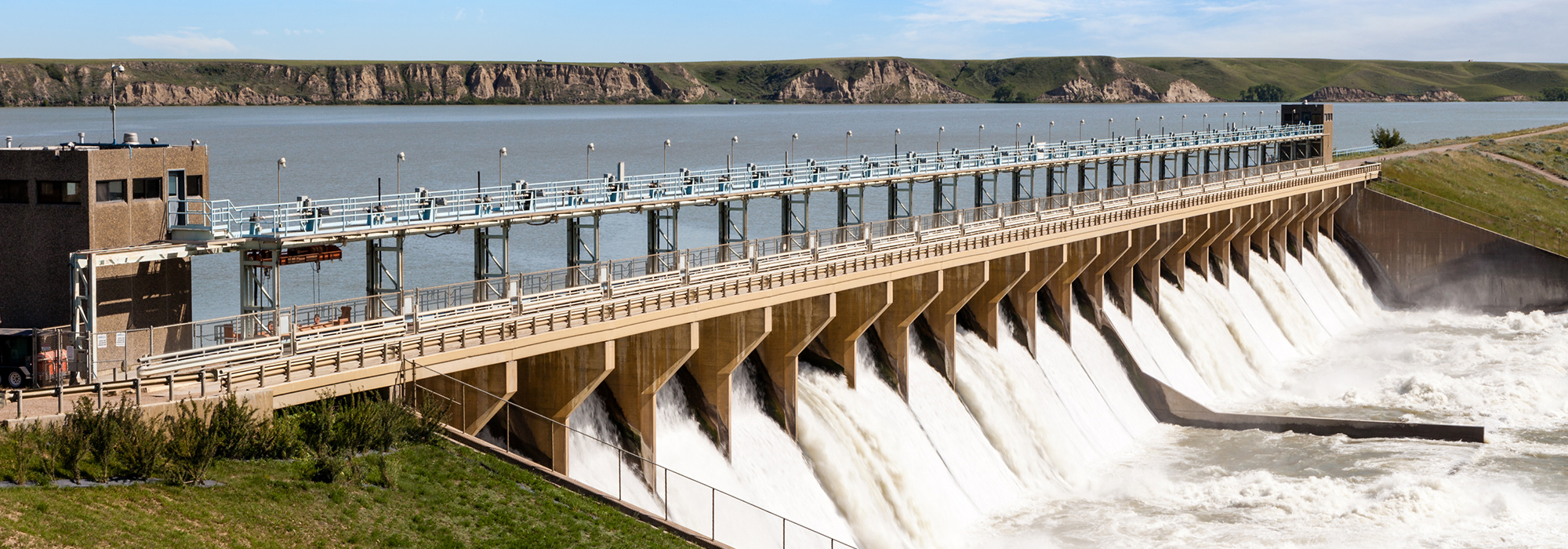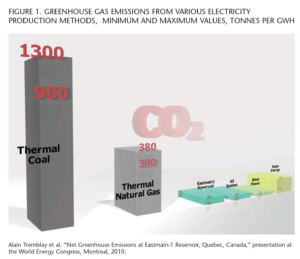
The US Energy Information Administration forecasts that world electricity generation will almost double between 2007 and 2035, while the International Energy Agency predicts that by 2040, world energy consumption will increase by 30 percent over 2010 levels, due to world population growth and accompanying economic growth.
On the one hand, strong growth in global electricity demand is desirable, in that it goes together with the rapid development of a number of emerging countries and signals a general improvement in their standard of living. On the other hand, a strong increase in global energy growth may be worrisome from the point of view of its environmental impact.
We believe it is possible to reconcile the growing need for energy, especially electricity, and the environmental imperatives associated with greenhouse gases (GHGs). It will require across-the-board energy efficiency gains, much less reliance on coal to generate electricity and advances in all forms of renewable energy, of which hydro-power is the prime example.
Coal is used to generate half of North America’s electricity. This poses a real environmental threat and is a real public health concern. North American coal-fired power plants are a major source of smog and other air pollutants, which cause serious health problems, including the respiratory ailments that are increasingly affecting people of all ages.
Fortunately, advances in renewables and the recent availability of natural gas at very competitive prices spell the end of coal-fired plants. In The Outlook for Energy — 2040, ExxonMobil predicts that for the first time global demand for coal will peak and then gradually decline.
Throughout the world, efforts are being made to generate more electricity from renewable energy sources. In 2010, global investments in renewables reached a record high of US$211 billion, up 32 percent from 2009. Energy companies are increasingly turning to renewables to meet their customers’ needs.
In Quebec, hydro-power is the cornerstone of electricity generation. Our great advantage is to have baseload energy derived from water resources, which are renewable. Unlike coal-fired power plants, for example, hydro-power generating stations do not emit pollutants that contribute to smog and acid rain.
In Quebec, in fact, atmospheric emissions from the generation and purchase of electricity are considerably lower than the average of our neighbouring provinces and states: 39 times less sulphur dioxide (SO2), 35 times less carbon dioxide (CO2) and 30 times less nitrogen oxide (NOx) per terawatt hour (TWh) of electricity produced.
While all electricity generation creates GHG emissions, whether directly or indirectly, hydro-power ranks as one of the lowest-emission generating options per kilowatt hour (kWh). Emissions from reservoir generating stations in Quebec are comparable to those produced by wind farms and about a quarter of those from photovoltaic solar facilities, mainly because of the processes involved in manufacturing wind turbines and solar panels.
A Hydro-Québec reservoir generating station produces around 100 times less greenhouse gas than a coal-fired plant and 40 times less than a gas-fired power plant (see figure 1).
Over 40 years of experience and scientific research into hydro-power developments have demonstrated that a Quebec reservoir is an aquatic ecosystem comparable to a natural lake. The new environment created by a reservoir provides the necessary habitat and food for rich and diverse aquatic and terrestrial communities. The various species go through their life cycles, and populations are maintained naturally. Furthermore, all natural aquatic areas emit GHGs.
From 2003 to 2009, a large-scale independent study was carried out by a team of 80 experts from the Université du Québec à Montréal, McGill University and Environnement Illimité Inc. to measure net GHG emissions from a reservoir in northern Quebec.
A Hydro-Québec reservoir generating station produces around 100 times less greenhouse gas than a coal-fired plant and 40 times less than a gas-fired power plant.
Using the most sophisticated, upto-date scientific techniques available, they collected and analyzed some 100,000 measurements. The object was to compare the emissions before and after impoundment of the Eastmain 1 reservoir, which covers some 600 km2. The researchers showed that net emissions increased after impoundment, but then quickly diminished.
Therefore, mean emissions from reservoir generating stations in Quebec are comparable to those produced by wind generation, and gross reservoir emissions are comparable to those of natural lakes. So of all generating options, hydro-power boasts one of the lowest levels of GHG emissions. (The results of the study can be found at https://hydro forthe future.com/energie/ 2/one-of-the-cleanest-generatingoptions.)
Worldwide, the two largest sources of GHG emissions are electricity generation and transportation. Public and personal transportation accounts for about a quarter of GHG emissions in North America. The situation is somewhat different in Quebec, however. Thanks to our hydro-power development, the electricity sector accounted for a mere 0.5 percent of Quebec’s GHG emissions in 2008, compared with 43 percent (36 million tonnes) for the transportation sector. While gas and oil have dominated the ground transportation sector for the last century, electricity will play an increasingly important role in both personal and public transportation from now on. Ensuring a cleaner power mix in the transportation sector is essential if we are to significantly reduce our carbon footprint.
The electric vehicle (EV) in all its forms — hybrid, plug-in hybrid, all-electric — is a major development in our industry. Many models are hitting the market: the Nissan LEAF, the GM Volt, the Mitsubishi i-MiEV, the Ford Focus, and the list goes on. Hydro-Québec is partnering with various car manufacturers, including Ford, Mitsubishi, Toyota and Renault-Nissan, to test and use plug-in, all-electric and hybrid vehicles before they are marketed on a large scale. These demonstration projects have been designed to determine the charging performance of vehicles, particularly under northern conditions, as well as driver experience and overall satisfaction.
In addition, last summer, Hydro-Québec and its partners, St-Hubert Restaurants, RONA, Metro and the Agence métropolitaine de transport (AMT), announced the first public EV charging infrastructure in Canada: the Electric Circuit.
Starting in spring 2012, the Electric Circuit will provide an accessible, easy-touse public service. Charging stations, supplied with Hydro-Québec’s clean, renewable energy, will be installed in a number of parking lots of the Electric Circuit’s founding partners.
Initially, the Electric Circuit will consist of over a hundred 240-V charging stations. Quick-charge stations will be introduced in 2012.
The network of charging stations will be rolled out gradually, as more EVs arrive on the Quebec market. The first public stations will be in the metropolitan areas of Montreal and Quebec City.
Battery materials are actually the key to a successful future for electric cars and buses. A very promising solution to increase the stability and safety of lithium-ion batteries, while reducing their cost, is to use a lithiumiron-phosphate (LiFePO4) cathode.
To ensure continued sustainable economic growth, the world must use its energy more efficiently. In 2003, Hydro-Québec introduced its Energy Efficiency Plan (EEP) to curb growth in electricity consumption, particularly in the residential sector, which was feeling the effects of a boom in the real estate market and increased use of electricity for various purposes.
We have achieved recurring annual savings of 5.3 billion kWh since the EEP was launched — equivalent to the consumption of approximately 330,000 households.
It is also important to concentrate on the development of all forms of renewable energy: hydro, wind, solar, biomass, geothermal, etc. There are no bad choices among them, and different regions will specialize in those that are in line with their natural resources and make sense for their markets.
In Quebec, however, the costs to customers of the various options must be taken into account. Wind power, for instance, costs just over 10¢ per kWh when generated fairly close to load centres. But if the electricity has to be transmitted over long distances, the cost shoots up, because new power lines have to be built.
Solar energy costs over 25¢ per kWh. In Ontario, for example, the feed-in tariff for solar power is between 44¢ and 80¢ per kWh. The large-scale implementation of this technology in Ontario, the United States, Germany and Spain has led to higher electricity rates for consumers.
Regions with a strong resource base for generating clean, renewable electricity can export more of that energy to neighbouring regions. For example, between 2008 and 2010, Hydro-Québec’s net electricity exports meant that North American GHG emissions were cut by 41 million tonnes. That is the equivalent of the annual emissions from about 10 million vehicles.
A low-carbon economy is not only possible, it is a necessity. Hydro-power, the most flexible and reliable renewable energy, is key to this sustainable energy future.
Photo: Shutterstock








